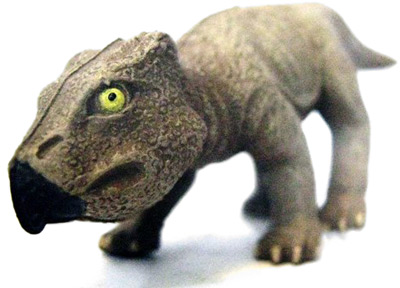
|
Search JoyZine with Google Site Search! |
Serendipaceratops
Serendipaceratops (meaning "serendipitous horned face") is a dubious genus ornithischian dinosaur from the early Cretaceous Period of Australia. The type species, S. arthurcclarkei, was named after Arthur C. Clarke, author of books such as 2001: A Space Odyssey and Rendezvous with Rama, who first became interested in science as a child because he became fascinated by dinosaurs. Perhaps coincidentally, "Serendip" is a former name for Sri Lanka, Clarke's adoptive country. The only known remains of Serendipaceratops were discovered in the Wonthaggi Formation of the Strzelecki Group, in "The Arch" on the shore platform near the village of Kilcunda, Victoria, Australia, by Tom Rich and Patricia Vickers-Rich in the early 1990s. The holotype (NMV P186385) is a partial left ulna (lower arm bone). The first known bone from Serendipaceratops was discovered in Australia near Kilcunda, on the south-east coast of Victoria. Initially, the discoverers, Tom Rich and Patricia Vickers-Rich, had not considered the possibility it may have been ceratopsian as at this would have been the last family of dinosaurs one would have expected to find evidence of in Australia. Instead they had tried to convince themselves it was a theropod bone. Some months later, however, on a visit to the Royal Tyrrell Museum of Palaeontology in Alberta, Canada, and a glance at the corresponding remains of Leptoceratops they noted a striking similarity between the two. If their new theory could be substantiated, not only would it push the origin of neoceratopsians back almost 30 million years but also shift it to the other side of the planet. But subsequent studies have shown that this interpretation is likely incorrect. In a comprehensive survey of the dinosaurs from Australia and New Zealand, Federico Angolin and colleagues found that the ulna did not particularly resemble that of a primitive ceratopsian any more than any other genasaurian ornithischian, and that in fact it was more similar to the ulna of the Australian ankylosaur Minmi. However, a single forearm bone isn't the most reliable yardstick when trying to link your new find to something that obviously has a horned face, albeit a modest one, and when Agnolin and colleagues inspected said bone they couldn't find any features to unite it with neoceratopsia nor many to separate it from an Australian ankylosaur called Minmi. All that can really be said about Serendipaceratops with any certainty is that it's a "genasaurian" — a name used almost exclusively by its creator Paul Sereno for the ornithischian group that includes neornithischia (marginocephalians, ceratopsians, pachycephalosaurs, cerapods and ornithopods) and thyreophora (stegosaurs and ankylosaurs). |
